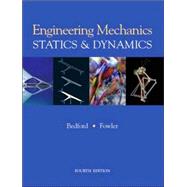
| Introduction | |
| Engineering and Mechanics | |
| Learning Mechanics | |
| Fundamental Concepts | |
| Units | |
| Newtonian Gravitation | |
| Vectors | |
| Vector Operations and Definitions | |
| Scalars and Vectors | |
| Rules for Manipulating Vectors | |
| Cartesian Components | |
| Components in Two Dimensions | |
| Components in Three Dimensions | |
| Products of Vectors | |
| Dot Products | |
| Cross Products | |
| Mixed Triple Products | |
| Forces | |
| Types of Forces | |
| Equilibrium and Free-Body Diagrams | |
| Two-Dimensional Force Systems | |
| Three-Dimensional Force Systems | |
| Systems of Forces and Moments | |
| Two-Dimensional Description of the Moment | |
| The Moment Vector | |
| Moment of a Force About a Line | |
| Couples | |
| Equivalent Systems | |
| Representing Systems by Equivalent Systems | |
| Objects in Equilibrium | |
| The Equilibrium Equations | |
| Two-Dimensional Applications | |
| Statically Indeterminate Objects | |
| Three-Dimensional Applications | |
| Two-Force and Three-Force | |
| Structures in Equilibrium | |
| Trusses | |
| The Method of Joints | |
| The Method of Sections | |
| Space Trusses | |
| Frames and Machines | |
| Centroids and Centers of Mass 316 | |
| Centroids | |
| Centroids of Areas | |
| Centroids of Composite Areas | |
| Distributed Loads | |
| Centroids of Volumes and Lines | |
| The Pappus-Guldinus Theorems | |
| Centers of Mass | |
| Definition of the Center of Mass | |
| Centers of Mass of Objects | |
| Centers of Mass of Composite Objects | |
| Moments of Inertia | |
| Areas | |
| Definitions | |
| Parallel-Axis Theorems | |
| Rotated and Principal Axes | |
| Masses | |
| Simple Objects | |
| Parallel-Axis Theorem | |
| Friction | |
| Theory of Dry Friction | |
| Applications | |
| Internal Forces and Moments | |
| Beams | |
| Axial Force, Shear Force, and Bending Moment | |
| Shear Force and Bending Moment Diagrams | |
| Relations Between Distributed Load, Shear Force, and Bending Moment | |
| Cables | |
| Loads Distributed Uniformly Along Straight Lines | |
| Loads Distributed Uniformly Along Cables | |
| Discrete Loads | |
| Liquids and Gasses | |
| Pressure and the Center of Pressure | |
| Pressure in a Stationary Liquid | |
| Virtual Work and Potential Energy | |
| Virtual Work | |
| Potential Energy | |
| Review of Mathematics | |
| Algebra | |
| Trigonometry | |
| Derivatives | |
| Integrals | |
| Taylor Series | |
| Vector Analysis | |
| Properties of Areas and Lines | |
| Areas | |
| Lines | |
| Properties of Volumes and Homogeneous Objects | |
| Answers to Even-Numbered Problems | |
| Engineering and Mechanics | |
| Engineering and Mechanics | |
| Learning Mechanics | |
| Fundamental Concepts | |
| Units | |
| Newtonian Gravitation | |
| Motion of a Point | |
| Position, Velocity, and Acceleration | |
| Straight-Line Motion | |
| Curvilinear Motion | |
| Force, Mass, and Acceleration | |
| Newton's Second Law | |
| Equation of Motion for the Center of Mass | |
| Inertial Reference Frames | |
| Applications | |
| Orbital Mechanics | |
| Numerical Solutions | |
| Energy Methods | |
| Work and Kinetic Energy | |
| Principle of Work and Energy | |
| Work and Power | |
| Work Done by Particular Forces | |
| Potential Energy | |
| Conservation of Energy | |
| Conservative Forces | |
| Relationship between Force and Potential Energy | |
| Momentum Methods. < | |
| Table of Contents provided by Publisher. All Rights Reserved. |
The New copy of this book will include any supplemental materials advertised. Please check the title of the book to determine if it should include any access cards, study guides, lab manuals, CDs, etc.
The Used, Rental and eBook copies of this book are not guaranteed to include any supplemental materials. Typically, only the book itself is included. This is true even if the title states it includes any access cards, study guides, lab manuals, CDs, etc.